中间滑脱层之下冲断系统构造指向的离散元模拟:对扎格罗斯简单褶皱带沿走向变化的启示(GSA Bulletin)
在冲断楔或褶皱-冲断带中,通常认为单个滑脱层只控制直接位于其上方冲断系统的构造指向(structural vergence)。然而,这一主流认识却无法解释沿扎格罗斯简单褶皱带(Zagros Simply Folded Belt)走向,广泛分布的基底滑脱层(霍尔木兹盐层)上方发育完全不同构造指向(包括前冲、双冲、后冲)的现象(图1)。此外,尽管中间滑脱层对扎格罗斯简单褶皱带构造样式的控制作用已得到广泛认知,但其对下伏冲断系统构造指向的影响机制仍不明晰。
针对上述科学问题,中国科学院青藏高原研究所何建坤研究员及其团队的博士生周超,王卫民副研究员,王信国高级工程师,与中国科学技术大学地球与空间科学学院的苏浩博士,西班牙高等科学研究委员会海洋科学研究所的Jonas B. Ruh博士,中国地震局地震预测研究所的王洵副研究员和潘正洋副研究员合作,依托国家自然科学基金项目(42120104004)和“第二次青藏高原综合科学考察研究”专项(2019QZKK0708)的资助,利用ZDEM软件(李长圣,2019)开展离散元数值模拟实验并进行应力应变分析(Morgan,2015),系统研究了中间滑脱层对其之下冲断系统构造指向的影响。
离散元数值模拟实验表明:
- 在基底滑脱层极其薄弱的条件下(μ = 0),通过改变中间滑脱层的强度、厚度和埋深,我们在中间滑脱层之下的冲断系统中重现了所有类型的冲断楔(即前冲、双冲、后冲)。这表明中间滑脱层的性质可决定其下方冲断系统的构造指向。这一发现对以往认为单个滑脱层只控制直接位于其上方冲断系统构造指向的传统认知提出了挑战;
- 中间滑脱层特性(强度、厚度与埋深)与缩短速率的特定组合,对其之下冲断系统中后冲冲断楔的发育至关重要。力学上,这些参数组合可能决定了上冲断系统对下冲断系统摩擦力的大小。因此,我们提出不同冲断系统之间的摩擦作用或可为后冲冲断楔的形成提供一种新的成因机制;
- 结合地质和地球物理观测,我们认为在扎格罗斯简单褶皱带的走向上,广泛分布的基底滑脱层(霍尔木兹盐层)之上出现的构造指向变化,可能源自中间滑脱层(加奇萨兰蒸发岩)在走向上强度、厚度和埋深方面的差异。因此,我们提出在未来的研究中应重视不同尺度冲断系统之间的相互作用。
题目
Discrete element modeling of the structural vergence beneath intermediate décollements: Implications for along-strike variations in the Zagros Simply Folded Belt
作者
Chao Zhou1,2, Jiankun He1,2, Hao Su3, Jonas B. Ruh4, Xun Wang5, Weimin Wang1, Xinguo Wang1, Zhengyang Pan5
- State Key Laboratory of Tibetan Plateau Earth System, Environment and Resources (TPESER), Institute of Tibetan Plateau Research, Chinese Academy of Sciences, Beijing 100101, China
- University of Chinese Academy of Sciences, Beijing 100049, China
- Laboratory of Seismology and Physics of Earth’s Interior, School of Earth and Space Sciences, University of Science and Technology of China, Hefei 230026, China
- Institute of Marine Sciences, Consejo Superior de Investigaciones Científicas, 08003, Barcelona, Spain
- Key Laboratory of Earthquake Forecasting, Institute of Earthquake Forecasting, China Earthquake Administration, Beijing 100036, China
- Correspondence to: Jiankun He (jkhe@itpcas.ac.cn) Hao Su (suhao1226@ustc.edu.cn)
摘要
In thrust wedges with multiple weak layers, individual décollements are generally thought to control only the structural vergence of the thrust systems directly above them. However, along the strike of the Zagros Simply Folded Belt, the structures above a common basal décollement at the Hormuz salt layer exhibit different vergence, including forward-, doubly-, and backward-vergent thrust wedges. Despite the importance of intermediate décollements for determining structural styles in the Zagros Simply Folded Belt, their effects on the structural vergence of the thrust system beneath them remain poorly understood. To address this issue, we conducted systematic experiments using discrete element models with a basal décollement on top of the basement and an intermediate décollement within the overlying strata. By varying the strength, thickness, and depth of the intermediate décollement, we successfully reproduced all types of thrust wedges (i.e., forward-, doubly-, and backward-vergent) in the thrust system beneath it. This suggests that intermediate décollements can determine the vergence of the thrust wedges beneath them. Moreover, our results reveal that specific combinations of intermediate décollement properties and shortening rates are crucial for the development of a backward-vergent thrust wedge in the thrust system beneath the intermediate décollement. This provides an alternative mechanism for the formation of such wedges. Together with geological and geophysical observations, we propose that intermediate décollements are responsible for along-strike vergence variations in the Zagros Simply Folded Belt. Thus, the interactions between thrust systems at various scales should be emphasized.
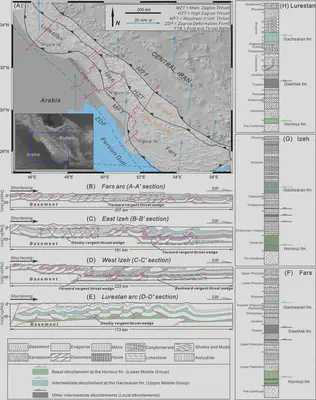
Figure 1. Simplified tectonics and cross sections across the Zagros Fold-and-Thrust Belt. (A) Topographic relief map showing the tectonics of the Zagros Fold-and-Thrust Belt (modified from Sherkati et al., 2006). Sky blue vectors show GPS velocities with respect to the stable Eurasia frame (after Vernant et al., 2004). (B–E) Cross sections across the northwestern Fars (modified from Sherkati et al., 2006), Izeh (modified from Sherkati et al., 2006), and Lurestan (modified from Farzipour Saein et al., 2009). (F–H) Stratigraphic column of the Fars (after Najafi et al., 2014), Izeh (modified from Najafi et al., 2018; Najafi and Lajmorak, 2020), and Lurestan (after Casciello et al., 2009). The topographic relief base maps were prepared with the Generic Mapping Tools software (Wessel and Smith, 1995).
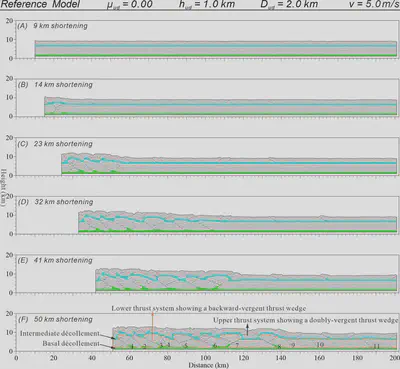
Figure 3. Sequential deformed particle results of reference model, with the black and magenta lines showing the thrusts formed in the lower and upper thrust systems, respectively. Numbering denotes the initiation sequence of thrusts (same in the following figures). μud—friction coefficient of intermediate décollement; hud—thickness of intermediate décollement; Dud—depth of intermediate décollement; v—shortening rate.
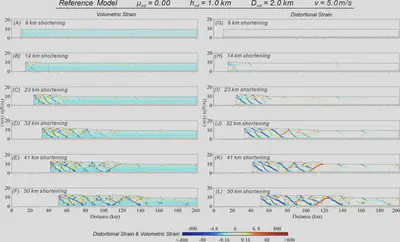
Figure 4. Sequential strain results of reference model. (A–F) Volumetric strain. (G–L) Distortional strain. Black and magenta lines show the thrusts formed in the lower and upper thrust systems, respectively. μud—friction coefficient of intermediate décollement; hud—thickness of intermediate décollement; Dud—depth of intermediate décollement; v—shortening rate.
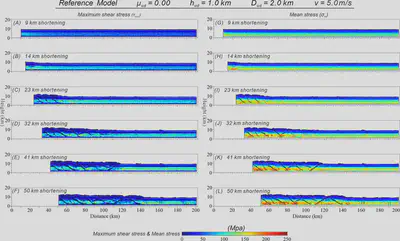
Figure 5. Sequential stress results of reference model. (A–F) Maximum shear stress (τmax). (G–L) Mean stress (σm). Black and magenta lines show the thrusts formed in the lower and upper thrust systems, respectively. μud—friction coefficient of intermediate décollement; hud—thickness of intermediate décollement; Dud—depth of intermediate décollement; v—shortening rate.
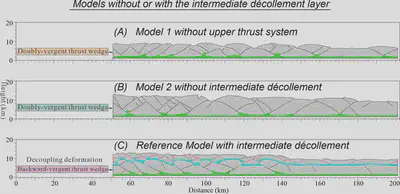
Figure 6. Final particle configurations for (A) Model 1 without upper thrust system; (B) Model 2 without intermediate décollement; (C) reference model. Black and magenta lines show the thrusts formed in the lower and upper thrust systems, respectively.
参考文献
限于篇幅,参考文献详见:Zhou, C., He, J., Su, H., Ruh, J.B., Wang, X., Wang, W., Wang, X., Pan, Z. (2025). Discrete element modeling of the structural vergence beneath intermediate décollements: Implications for along-strike variations in the Zagros Simply Folded Belt. GSA Bulletin. https://doi.org/10.1130/B37988.1